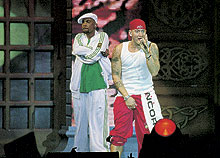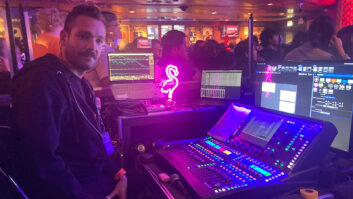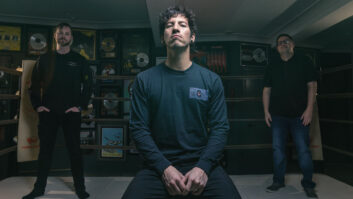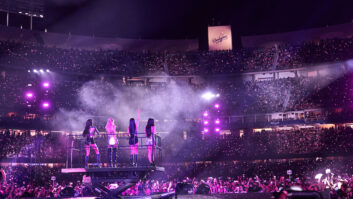
Eminem (right) rapping with a member of G-Unit
all photos: FUBZ
A five-day August heat wave has just broken, but temperatures are rising at the Tweeter Center Pavilion in Philadelphia. Earlier in the day, Lil John has crunked it up with the East Side Boyz, and 50 Cent’s blistering set — with G-Unit’s Tony Yayo, Lloyd Banks and newly signed rap veterans Mobb Deep and M.O.P. among the special guests — has raised the sweat factor a few degrees. As the capacity crowd anxiously awaits the arrival of the real Slim Shady, huge video screens on either side of the stage fire up a quick documentary primer on Eminem’s rise to fame, and within moments, the man himself emerges to the trunk-bumping rhythms of “Evil Deeds,” the feverish opener from last year’s multi-Platinum album Encore. The effect is sheer pandemonium.
“It’s on!” squeals an excited teenager as she attempts to squeeze her way with about a dozen of her closest friends toward the front. Meanwhile, behind the mixing desk about 40 rows from the stage, the crew from Eighth Day Sound is on point, filling the semi-enclosed amphitheater with a pristinely mixed bed of subsonic boom and crystalline bap as Eminem’s rapid-fire vocal soars over the top. Front-of-house engineer Tim Colvard, at the controls of a DiGiCo D5 console, bobs his head to the beat, while crew chief and systems engineer Mark Brnich calmly monitors levels and EQ on a wireless tablet that controls a bank of Lake Contour digital speaker processors onstage. After a solid three months on the road with Anger Management 2005, these guys have it down to a science.

Lil John takes to the stage with his East Side Boyz—sans Crunk Juice
“Tim and I have worked on quite a few gigs over the last few years,” Brnich explains backstage before the show. “We did the Up In Smoke tour with Dr. Dre a few years ago; we’ve worked with Eminem and with 50 Cent before; and Tim has done a lot of Earth, Wind & Fire gigs with equipment similar to what we have now. And over that length of time, we’ve actually gone back to the idea of ‘less is more’ when it comes to getting a good live sound.”
At the heart of that sound is the L-Acoustics V-DOSC line array system, which Eighth Day acquired back in 2001. Powered by Lab.gruppen amplifiers, the rig was configured on this night into two 16-cabinet clusters on the left and right, with smaller arrays of dV-DOSC enclosures to help fill in the sides of the venue.

Eighth Day Sound crew chief/systems engineer Mark Brnich
“You get a lot of control with the V-DOSC system, as far as being able to aim into the room and get an even coverage from front to back,” Brnich says. “Plus, you get a lot less surface reflection than you would with a multiple-box system.” The wireless controller also allows Brnich to walk anywhere in the venue, “even way out on the lawn if I need to.” It also allows him to make micro-changes to EQ, gain, delay and other parameters. With an almost completely digital signal path from microphone to P.A. (only the output from the Lake Contours to the amplifiers runs in analog), the Eighth Day setup is stripped-down, state-of-the-art and, for a tour this size, now practically the industry standard.
HIT ME WHERE IT HERTZ
As soon as Lil John takes the Philly stage to get the party started, it hits you: a ribcage-rattling rumble from an 808 kick drum that seems to make the earth move, but without any of the deafening roar or painful midrange distortion that can come from an unduly overdriven bass tone. For Brnich and Colvard, this is the payoff from their years of hard work and experimentation. They’ve been tweaking the system to the point where the lower registers — such a crucial part of a real hip hop experience — exert a huge, gravy-thick and wide presence that was unheard of a decade ago.
“Until recently, I never thought I’d be trying to get so much low end out of the P.A. without pushing the gear,” Brnich admits, marveling at how much the demands on today’s sound systems have changed. “It’s a very important part of getting a good show with hip hop, so you need to get that as tight-sounding as you can. Tim and I have worked a lot on subwoofers, using delays and phasing and time alignment to get the most out of the system.”

Monitor engineer Sean Sturge
Throughout the tour, the Eighth Day crew have availed themselves of dV-DOSC subs, some of which are flown with the main P.A. hang, with more positioned on the ground. Using Soundweb Designer (which toggles on and off with JBL Smaart software on one of the three monitor displays near the D5 console), the air and ground subs are phase-corrected, depending on the venue’s size and shape.
“We use Smaart mostly for reference and monitoring during the show,” Brnich explains, “and we might also use it for select EQ touchups from day to day. But for the low-end adjustments and time alignment in particular, Soundweb works really well for us. There’s a phase module inside it, and I’ve built some presets in there so I can quickly switch between different settings and check out which one works best. This especially helps when you’re playing different sheds and arenas, where the roof is not the same every night. The distance between speaker clusters might be slightly different, but I can fix that by picking the best preset and then making very minute adjustments to get the subs as close together as I can.”

Tim Colvard, Eminem FOH
Of course, there are times when a little effects-driven juice can help drive the bass home, too. “Tim uses a dbx 120 sub-harmonic synthesizer on some songs for Eminem,” Brnich says, “and there are some other effects we might use on other parts of the mix, but nothing really unusual. We have a couple of Yamaha SPX-990s, an Eventide Harmonizer and a TC Electronic 6000 reverb and a 2290 delay. It’s all stuff that Tim is really familiar with, so we haven’t really bothered too much with the internal effects on the DiGiCo.”
RHYME POWER
As virtually all of the backing tracks at most headlining hip hop tours come from pre-recorded sessions, it has often been assumed — mostly by grizzled road dogs of the arena rock era — that it takes a lot more preparation and effort to mix a live rock band than it does a rap group with a DJ. But as Brnich tells it, nothing could be further from the truth.
“If anything, it can be more of a challenge,” he asserts. “If you’ve got a band up there — let’s say you have bass, drums, guitar and keyboards — these guys are playing the same instruments the whole time, so you can kind of get a blend of what their sound is and maybe float a lead singer on top of that. But when you’ve got six or eight guys up there, like we do for a couple of songs during 50 [Cent]’s set, and they’re all lead singers trading verses during a rap, it can be much busier onstage. One song might have six guys and the next might have a different group altogether, and they all have different qualities to their vocals. So it can be a real challenge trying to keep the sound clean and clear between all of them.

Anger Management’s front-of-house world
“We used to always use Shure mics,” Brnich says, “but with hip hop and rap, most of the guys tend to handle the mic really close up and cover it a lot, so you get kind of a ‘skronk’ sound coming from it. We’ve been using Sennheiser [SKM-5000s] for at least four years or so, going back to the Up In Smoke tour, and have stuck with them ever since. They seem to be built for that kind of mic technique and the EQ that we can get on them works a lot better — you can get everyone clear and separated from one another.”
Compression certainly helps in some cases. As monitor systems engineer Sean Sturge has mentioned in past interviews with Mix [“Up In Smoke,” December 2000], the onstage volume can get loud, which undoubtedly ups the energy level for the performers and inspires a louder, more intense vocal delivery. “For Eminem, there’s an Avalon [VT-737SP tube preamp/compressor] inserted on his vocal,” Brnich says, pointing to the rack unit next to the mixing console. “All the mics go directly [via wireless] into the desk, so compression is usually the only thing that we’ll use. We’ve been doing very similar things on a lot of other gigs. The DiGiCo’s got full compressor gates in it, so we’ll use those for vocals, but there’s nothing external except for the few effects we have here. It’s very in-and-out, with not much in-between.”

50 Cent sharing the stage with Tony Yayo
BACK ON THE FLIGHT DECK
Brnich takes the controls for 50 Cent, and he’s all business as G-Unit’s DJ Whoo Kid cues up tracks from the stage. If sunlight happens to reflect off any of the D5’s four built-in screens, Brnich can switch the same displays to another monitor angled next to the console to get a better look at what’s happening. Meanwhile, the second of the three monitor displays (the other being designated, as noted above, for Soundweb and JBL Smaart) shows the progress of Steinberg Nuendo as it records the show live to hard disk. These recordings are mostly for reference to soundcheck at the next stop on the tour, but there are always four audience mics positioned at every show in case there is ever a future need to do a mixdown for a live album.
After the set, Brnich takes a break to stress the point once again that although this may look easy, a significant amount of hard work and dedication has gone into making Anger Management a consistent draw and a top-flight tour. “Like you just saw,” Brnich says, “when you have five or six singers trading off, you need to be able to have them cut through and still keep that well-rounded mix. And as I’ve said, it’s sometimes a lot harder to deal with that than it is with a full band. The most important thing is preserving that big, low-end sound. Everyone who comes here expects to experience a great show, and that’s what we’re here to give them.”
Bill Murphy is a frequent contributor to Remix magazine, a Mix sister publication.







